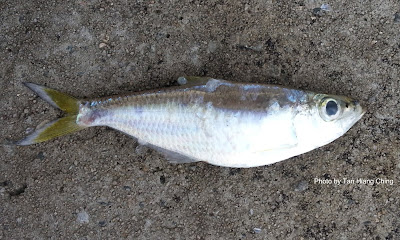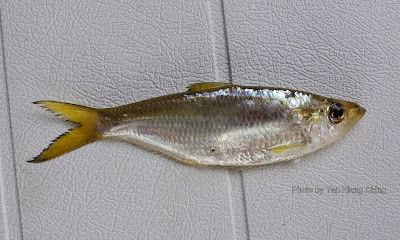Longfin Herrings
Longfin herrings, ilishas, pelonas and pristigasters are the common names used for the members of the Pristigasteridae family. They are moderate-sized fish, recognized by their terminal mouth, complete series of scutes along the abdomen, and long anal fin.
Longfin herrings are found in all seas from about 30°N to 30°S. They are typically marine fishes but can also be found in brackish and freshwater. A few species in South America appear to be restricted to fresh water. Most of them inhabit shallow coastal waters and estuaries. They frequently occur in large schools. Most species feed on small planktonic animals.
There are 9 genera and about 38 species of Pristigasteridae worldwide. Malaysia has about 4 genera and about 12 species.
Longfin herrings are found in all seas from about 30°N to 30°S. They are typically marine fishes but can also be found in brackish and freshwater. A few species in South America appear to be restricted to fresh water. Most of them inhabit shallow coastal waters and estuaries. They frequently occur in large schools. Most species feed on small planktonic animals.
There are 9 genera and about 38 species of Pristigasteridae worldwide. Malaysia has about 4 genera and about 12 species.
Scientific Name: Ilisha elongata (Anonymous [Bennett], 1830)
English Name: Elongated Ilisha
Malay Name | Nama Melayu Malaysia: Ikan Beliak Mata, Ikan Puput, Puput Bulan
Thai Name | ชื่อสามัญภาษาไทย: ปลาอีปุคยาว (Plā ī pukh yāw)
Main Identification Features: Body slender, depth 27 to 31% standard length. Eye large, lower jaw projecting. Anal fin origin at or slightly posterior to vertical through base of posterior most dorsal-fin ray.
Size: Maximum total length 60 cm, commonly to 30 cm.
Habitat and Ecology: Shallow coastal and estuarine waters, to 50 m depth. Pelagic and schooling species. Adults inhabit coastal waters, entering estuaries to spawn. Juveniles inhabit estuaries and around river mouths. Juveniles feed on zooplankton. Adults feed mainly on small fishes and crustaceans.

Scientific Name: Ilisha kampeni (Weber & de Beaufort 1913)
English Name: Kampen's Ilisha
Malay Name | Nama Melayu Malaysia: Ikan Puput, Peruput, Mata Lebar, Belalak Mata, Puput Belalak
Thai Name | ชื่อสามัญภาษาไทย: ปลาอีปุด (Plā ī pud)
Main Identification Features: Body moderately slender. Eye large, lower jaw projecting. Dorsal fin origin at about midpoint of body. Anal fin origin under hind part of dorsal fin base. Vertical striae on scales not continuous, but with a distinct gap across center of scale.
Size: Maximum standard length 15.0 cm.
Habitat and Ecology: Shallow coastal and estuarine waters, to 50 m depth. Feeds on planktonic crustaceans, fishes and amphipods.

Scientific Name: Ilisha megaloptera (Swainson, 1839)
English Name: Bigeye Ilisha
Malay Name | Nama Melayu Malaysia: Ikan Beliak Mata, Ikan Puput, Puput Melaka
Thai Name | ชื่อสามัญภาษาไทย: ปลาอีปุดตาโต (Plā ī pud tāto)
Main Identification Features: Body moderately deep, depth 28 to 39% standard length, with 28 to 35 sharply-keeled scutes. Eye large, lower jaw strongly projecting. Mouth directed obliquely upward. Dorsal fin origin near midpoint of body. Anal fin origin posterior to vertical through base of posterior most dorsal-fin ray.
Size: Maximum standard length 36.5 cm.
Habitat and Ecology: Shallow coastal and estuarine waters, to 50 m depth. Pelagic and schooling species. Adults inhabit coastal waters, entering estuaries to spawn. Juveniles feed on zooplankton. Adults feed mainly on small fishes and crustaceans.

Scientific Name: Ilisha melastoma (Bloch & Schneider, 1801)
English Name: Indian Ilisha
Malay Name | Nama Melayu Malaysia: Ikan Beliak Mata, Ikan Puput, Puput Bersia, Tirok, Kirang-kirang
Thai Name | ชื่อสามัญภาษาไทย: ปลาอีปุดตาโต (Plā ī pud tāto)
Main Identification Features: Body moderately deep, depth 33 to 42% standard length, with 25 to 30 sharply-keeled scutes. Eye large, lower jaw strongly projecting. Mouth directed obliquely upward. Dorsal fin origin a little before midpoint of body. Anal fin origin at point equal with or slightly posterior to vertical through bases of posterior dorsal-fin rays. Anal fin with with 35 to 48 fin rays.
Size: Maximum standard length 22 cm.
Habitat and Ecology: Shallow coastal and estuarine waters, to 50 m depth. Pelagic and schooling species. Feed on plankton.

Scientific Name: Opisthopterus tardoore (Cuvier, 1829)
English Name: Tardoore
Malay Name | Nama Melayu Malaysia: Ikan Puput, Menipis Ekor Panjang
Thai Name | ชื่อสามัญภาษาไทย: ปลาอีปุดหัวเล็ก (Plā ī pud h̄ạw lĕk)
Main Identification Features: Body elongate and strongly compressed, depth 27 to 33% standard length. Eye large, lower jaw projecting but short. Pectoral fins relatively long, equal to or longer than head. Pelvic fins absent. Anal fin long, with 51 to 63 fin rays.
Size: Maximum standard length 20 cm.
Habitat and Ecology: Shallow coastal and estuarine waters, to 50 m depth. Pelagic and schooling species. Feed on bivalve eggs and larvae, amphipods, small fishes, mysids, prawns, and other small crustaceans.

English Name: Elongated Ilisha
Malay Name | Nama Melayu Malaysia: Ikan Beliak Mata, Ikan Puput, Puput Bulan
Thai Name | ชื่อสามัญภาษาไทย: ปลาอีปุคยาว (Plā ī pukh yāw)
Main Identification Features: Body slender, depth 27 to 31% standard length. Eye large, lower jaw projecting. Anal fin origin at or slightly posterior to vertical through base of posterior most dorsal-fin ray.
Size: Maximum total length 60 cm, commonly to 30 cm.
Habitat and Ecology: Shallow coastal and estuarine waters, to 50 m depth. Pelagic and schooling species. Adults inhabit coastal waters, entering estuaries to spawn. Juveniles inhabit estuaries and around river mouths. Juveniles feed on zooplankton. Adults feed mainly on small fishes and crustaceans.

Scientific Name: Ilisha kampeni (Weber & de Beaufort 1913)
English Name: Kampen's Ilisha
Malay Name | Nama Melayu Malaysia: Ikan Puput, Peruput, Mata Lebar, Belalak Mata, Puput Belalak
Thai Name | ชื่อสามัญภาษาไทย: ปลาอีปุด (Plā ī pud)
Main Identification Features: Body moderately slender. Eye large, lower jaw projecting. Dorsal fin origin at about midpoint of body. Anal fin origin under hind part of dorsal fin base. Vertical striae on scales not continuous, but with a distinct gap across center of scale.
Size: Maximum standard length 15.0 cm.
Habitat and Ecology: Shallow coastal and estuarine waters, to 50 m depth. Feeds on planktonic crustaceans, fishes and amphipods.

Scientific Name: Ilisha megaloptera (Swainson, 1839)
English Name: Bigeye Ilisha
Malay Name | Nama Melayu Malaysia: Ikan Beliak Mata, Ikan Puput, Puput Melaka
Thai Name | ชื่อสามัญภาษาไทย: ปลาอีปุดตาโต (Plā ī pud tāto)
Main Identification Features: Body moderately deep, depth 28 to 39% standard length, with 28 to 35 sharply-keeled scutes. Eye large, lower jaw strongly projecting. Mouth directed obliquely upward. Dorsal fin origin near midpoint of body. Anal fin origin posterior to vertical through base of posterior most dorsal-fin ray.
Size: Maximum standard length 36.5 cm.
Habitat and Ecology: Shallow coastal and estuarine waters, to 50 m depth. Pelagic and schooling species. Adults inhabit coastal waters, entering estuaries to spawn. Juveniles feed on zooplankton. Adults feed mainly on small fishes and crustaceans.

Scientific Name: Ilisha melastoma (Bloch & Schneider, 1801)
English Name: Indian Ilisha
Malay Name | Nama Melayu Malaysia: Ikan Beliak Mata, Ikan Puput, Puput Bersia, Tirok, Kirang-kirang
Thai Name | ชื่อสามัญภาษาไทย: ปลาอีปุดตาโต (Plā ī pud tāto)
Main Identification Features: Body moderately deep, depth 33 to 42% standard length, with 25 to 30 sharply-keeled scutes. Eye large, lower jaw strongly projecting. Mouth directed obliquely upward. Dorsal fin origin a little before midpoint of body. Anal fin origin at point equal with or slightly posterior to vertical through bases of posterior dorsal-fin rays. Anal fin with with 35 to 48 fin rays.
Size: Maximum standard length 22 cm.
Habitat and Ecology: Shallow coastal and estuarine waters, to 50 m depth. Pelagic and schooling species. Feed on plankton.

Scientific Name: Opisthopterus tardoore (Cuvier, 1829)
English Name: Tardoore
Malay Name | Nama Melayu Malaysia: Ikan Puput, Menipis Ekor Panjang
Thai Name | ชื่อสามัญภาษาไทย: ปลาอีปุดหัวเล็ก (Plā ī pud h̄ạw lĕk)
Main Identification Features: Body elongate and strongly compressed, depth 27 to 33% standard length. Eye large, lower jaw projecting but short. Pectoral fins relatively long, equal to or longer than head. Pelvic fins absent. Anal fin long, with 51 to 63 fin rays.
Size: Maximum standard length 20 cm.
Habitat and Ecology: Shallow coastal and estuarine waters, to 50 m depth. Pelagic and schooling species. Feed on bivalve eggs and larvae, amphipods, small fishes, mysids, prawns, and other small crustaceans.